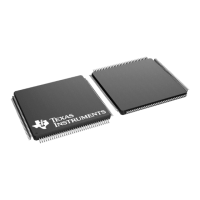www.ti.com
Software shutdown of PMIC not operational
39
SPRUI97D–May 2017–Revised September 2019
Submit Documentation Feedback
Copyright © 2017–2019, Texas Instruments Incorporated
Known Deficiencies in AM571x IDK EVM
A.8 Software shutdown of PMIC not operational
The PMIC is implemented to support PORz generation whenever any reset is initiated within the AM5718
SOC. This is enabled by pulling PMIC BOOT1 to VRTC. This has the side effect of requiring that PMIC
GPIO7/POWERHOLD also be pulled high. This results in an “always on” design that cannot be shut-off by
software. An external PORz pulse generator like that implemented on the X15 GP EVM would need to be
used to enable this feature. Please refer to i862 in the errata document for more information.
A.9 CCS System Reset fails
Warm reset and emulation reset events configured for warm reset cause the Texas Instruments Code
Composer Studio™ (CCS) integrated development environment (IDE) to issue an error message. This is
due to the reset erratum that requires all resets to trigger a PORz low event. Since this is not expected by
CCS when it initiates a warm reset, it loses its context and issues an error. Newer versions of CCS handle
this event better but an error message will always be generated.
A.10 AM571x IDK EVM design contains 2 clamp circuits that may not be necessary
During early investigation of power shut-down sequencing, it was determined that clamps were required
on every 3.3V supply to the dual-voltage I/O cell supplies (VDDSHVx). This would enforce the requirement
shown in Figure 5-3 of the AM571x Sitara Processors Silicon Revision 2.0 Data Manual (SPRS957) that
states that the 3.3V supply inputs must never be more than 2.0V above the VDDS18V supply, even during
ramping up or ramping down. The AM571x IDK EVM design contains these clamp circuits on both V3_3D,
that powers almost all VDDSHVx supplies, and VSDMMC, that powers VDDSHV8 used with the SDCARD
on MMC1. Later it was determined that the only method to maintain device reliability was to fully enforce
the supply sequence requirements shown in Figures 5-1 and 5-2 of the AM571x Sitara Processors Silicon
Revision 2.0 Data Manual (SPRS957). The companion PMIC, TPS6590377, was enhanced to provide a
shortened shut-down sequence that enforces the DM requirements in a time period (~1ms) that the PMIC
input can hold up the supplies. The PMIC also has supply discharge resistors to pull down the supplies
quickly when they are turning off. These 2 capabilities in the companion PMIC make the clamp circuits
superfluous. However, designs that use REGEN1 to power the VDDSHVx supplies through a power
switch will still need the clamp circuit. The power switches available do not discharge the supplies quick
enough.
A.11 Crystal connected to osc0 needs to have 50ppm or better long term accuracy
The crystal connected to osc0 needs to have 50ppm or better long term accuracy since it generates
clocks used for Ethernet interfaces. The current crystal has 30ppm accuracy and 50ppm temperature
variation for a combined tolerance of 80ppm. It also has aging of 2ppm per year.
A.12 Software must program the CDCE913 for 0pf load capacitance
Software must program the CDCE913 for 0pf load capacitance to allow crystals to operate at their target
frequency. Crystal load capacitors can be added to the oscillator circuit to allow the generated clock to
output at the required nominal frequency so that this programming is not required. The default capacitance
within the CDCE913 is 10pF so the capacitors C172, C173, C193, and C194 should be 8pF. Please refer
to the CDCE(L)913: Flexible Low Power LVCMOS Clock Generator With SSC Support for EMI Reduction
Data Manual (SCAS849) for more information. Also note that these clock generators are used to drive
Ethernet circuitry, so the same crystal accuracy requirement from Section A.11 applies to these crystals
as well.
A.13 Protection diode D2 should be rated for 5V
Protection diode D2 has the wrong value. It is meant to conduct current, if a voltage too large is connected
to the IDK. This current surge should blow the fuse before ICs are damaged. The current part SMCJ26CA
is rated for 26V. It should be replaced with SMCJ5.0A that is rated to protect a 5V-input power supply
circuit.

